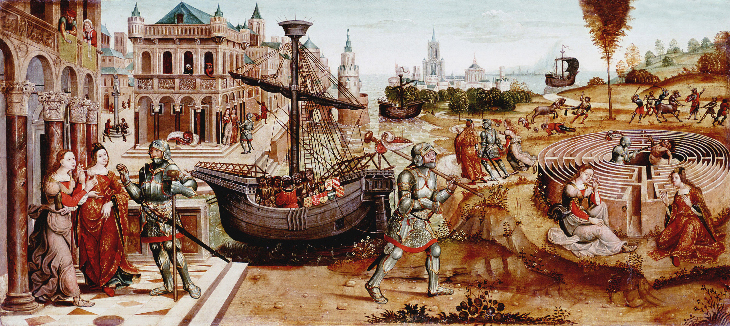When Boris Johnson resigned recently he automatically gave up his right to use Chevening House in Kent, bequeathed by the Earl Stanhope for the use of a person nominated by the prime minister, traditionally the foreign secretary. I think I’m right in saying that when she first came to office, Theresa May attempted to get Boris to share the place with David Davis and Liam Fox, but to no avail, which was surely a sign of things to come. Among its many attractions and allurements — 115 rooms, a boating lake, all the other usual country-house trimmings — Chevening has a magnificent maze, planted by the 4th Earl Stanhope, to a design by his great-grandfather, Philip Stanhope. One can easily imagine Boris during his powerless years in power, wandering among Chevening’s ancient yew hedges, trapped like the Minotaur.
According to Adrian Fisher, the world’s leading maze-designer, we’re living in a Golden Age of mazes. He would say that, wouldn’t he — he’s built more than 700 of the things all over the place, from Denmark to Dubai, including mirror mazes, hedge mazes and tiny little run-your-finger-along-the-line mazes; but there’s undoubtedly something about the now that seems to suggest the maze, a place where we are lost and wandering, unable to see a way ahead, disorientated, discombobulated, confused and confined. The maze is a useful symbol for our current crisis.
It’s a symbol for just about everything else too. Like a couple of overexcited, lost children on a school trip to Hampton Court, Charlotte Higgins and Henry Eliot bump into each other continually in two new books about mazes, which between them cover every aspect of the history and possible meaning of the maze, from Greek myths to Freud and Borges and back again.
In Red Thread: On Mazes & Labyrinths, Higgins, the chief cultural commentator for the Guardian, has produced a serious, substantial, scholarly and yet also highly personal book about mazes. Red Thread is perhaps reminiscent of Tim Robinson’s books about Connemara, or the work of Rebecca Solnit — not so much A Field Guide to Getting Lost as a circuitous route along some long and winding roads.
Red Thread is a book to admire as much as to enjoy, often unexpected and intense, and occasionally shading into rather self-conscious lyricism:
On the path of my life, in the middle of my life, what do I know about where I have been, and where I might go? Everything is the woods, everything is the ocean, everything is the desert. I can see no shape. I am lost; in the middle of my life I am lost.
Admittedly, one knows the feeling.
But it’s not all self-journeyings and self-discoveries. Higgins recounts the history of Sir Arthur Evans’s famous excavations and traces the lines of mazes and labyrinths through turf mazes, Renaissance hedge mazes and through art, literature, science and religion. Her interest in mazes began on a childhood holiday in Crete, where she was taken on a tour of the palace of Knossos:
I remember how much I wanted these narrow rooms and passages to be labyrinthine, to trap and contain me, to be magical, to be a code, to be something that could be unlocked. I wanted to lose myself in them. This was where it began, my longing for the labyrinth.
Higgins’s longtime longing eventually leads her as an adult to seek out the woman who had been her tour guide on that childhood trip — a Mrs Grammatiki — and she strikes up an extraordinary correspondence with her. Red Thread follows many such fine threads with tremendous and unembarrassed boldness. The book ends, weirdly yet appropriately, with Higgins’s translation of Peliaco quondam, Catullus 64, his mini-epic about Ariadne and Theseus. Imagine Kenneth Clark at the end of Civilisation banging out a sonnet sequence.
Henry Eliot’s Follow This Thread, meanwhile, is published by Particular Books, an imprint of Penguin, and is a very particular book indeed: particular to the point of peculiar. Higgins’s book may be highly original but it’s nonetheless recognisable; Eliot’s is genuinely odd. It’s really three books in one: a non-fiction investigation of mazes in general; a work of fiction about Daedalus, Theseus and the Minotaur; and a description of Eliot’s search for a man named Greg Bright, a classic English eccentric and maze pioneer, who designed the maze at Longleat and then promptly disappeared. The book is also designed and illustrated, by a Frenchman named Quibe — I did say it was odd — to resemble the experience of moving through a maze, with pages upside down and back to front, etc.
Eliot’s previous book Curiocity: An Alternative A-Z of London (2016) was described by Philip Pullman, in full Leonard Sachs mode, as:
The most ingenious, informative, inimitable, individual, innovative, insightful, inspiring, instructive, intelligible, intoxicating, intricate guide to the great city that I have ever seen.
You get the idea: Eliot is absolutely out there and Follow This Thread is the kind of book you’ll either find utterly baffling and annoying, or you’ll want to buy copies for all your friends.
The book begins with a bravura account of Daedalus’s long journey towards becoming a maze-maker:
Amongst the clouds there is a bird, too distant to make out clearly. Its flight is clumsy as it approaches, its tattered wings barely holding the thin air…. A man crawls free of the wreckage. He has flown more than 1,000 miles with arms strapped to artificial wings.
Eliot then settles into a rhythm and pace entirely of his own invention, which roughly consists of one or two pages of maze factoids, followed by retellings of the myth of the Minotaur. Thus, in quick succession we get Kafka on mazes, Victor Hugo, then Daedalus, Walter Benjamin, the Situationists, Theseus, Picasso, Mircea Eliade, Ariadne, W.G. Sebald, Guillermo del Toro’s Pan’s Labyrinth, The Shining, Scaramanga in The Man With the Golden Gun, rats, Chartres, and poor old Aegeus.
There is perhaps a tendency throughout Eliot’s book towards Wikipediaese, but it does mean that you learn a lot about mazes in a very short space of time. I did not know, for example, that there is a maze in Argentina which spells out the name of Jorge Luis Borges, or that a Wall Street banker called Armand Erpf commissioned the world’s largest masonry maze in Delaware, or that Charles Dodgson used to stamp labyrinths into the snow outside his father’s rectory —and I’d had the advantage of having read Higgins’s history of mazes before starting Eliot’s. I knew, for example, from Higgins all about the artist Mark Wallinger’s famous labyrinth project on the Tube, but I did not know that the maze mosaics on the Victoria line platforms at Warren Street station were intended by their designer, Alan Fletcher, to take four minutes to solve, which is longer than the average three-minute wait between trains. ‘Who’d have thought, eh?’ is presumably the response that Eliot intends you to have to the book. Who’d have thought indeed.
Buried deep within the musing and meandering pages of Follow This Thread is Eliot’s account of his search for Greg Bright, the self-styled Maze King. Suffice it to say that Eliot does eventually find this elusive figure, but things do not go entirely according to plan. It turns out that Bright, who did much to develop the practice and mathematics of contemporary maze-making, has come to loathe mazes and all they stand for. He’s particularly scathing about recent ‘improvements’ to his famous maze at Longleat to make it more visitor friendly. ‘Frivolity is a major gangrene of the psyche,’ he tells Eliot. ‘I have never been complicit with the “fun and games” angle.’ The fun and games angle is more than sufficiently covered in Eliot’s book.
There have of course been many books about mazes before. Michael Ayrton, the writer and sculptor, was obsessed with the story of Daedalus and published a couple of books back in the 1960s, The Testament of Daedalus (1962) and The Maze Maker (1967), which were the sort of thing everyone read alongside Erich von Daniken’s Chariots of the Gods and Carlos Casteneda. Mazes always seem to attract oddballs. Jeremy Hunt should beware: it undoubtedly takes a lot of hard work to get into Chevening, but it’ll require real cunning to get out.
Got something to add? Join the discussion and comment below.
Get 10 issues for just $10
Subscribe to The Spectator Australia today for the next 10 magazine issues, plus full online access, for just $10.
You might disagree with half of it, but you’ll enjoy reading all of it. Try your first month for free, then just $2 a week for the remainder of your first year.














Comments
Don't miss out
Join the conversation with other Spectator Australia readers. Subscribe to leave a comment.
SUBSCRIBEAlready a subscriber? Log in